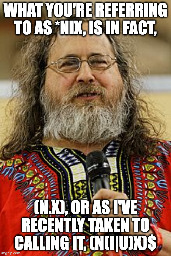*nix doesn't make sense




Wasn't there some controversy about this that it wasn't entirely open-source?
Worse how? Jellyfin was forked from Emby, and since then has continued to improve in my eyes.
Feel you there. 4 hours here. All of them cloud instances whereby getting acces to the actual console isn't as easy as it should be, and trying to hit F8 to get the menu to get into safe mode can take a very long time.
That's...Awesome! Thank you!

If you think that's bad, Oracle renamed their LTS DB product from 23c to 23ai the other day.

Didn't something similar just happen with RustDesk? ChatGPT response from author in an hours old account.
However, distributions like Fedora will definitely be in the lead, judging by previous experiences and stories of adapting new Linux technologies and Systemd components.
I wonder if this is still true, now that he no longer works for RedHat, but Microsoft.
I had to upgrade some OL6 VMs to OL7 VMs running Oracle DBs and Apps (on OVMM no less). There was no appetite for buying additional storage, or restoring the environments with RMAN. Luckily, everything had been installed under /u01 which was on its own virtual disk.
So I built a new VM as OL7 (same hostname, etc.), installed the pre-req RPMs for Oracle DB, disconnected the virtual disk from the OL6 and attached it to the new OL7, synced users and home dirs - and it only bloody worked.
I don't want to be a pain, but it's not "basically Mint running on an M1 iMac." it's Asahi/Fedora running Cinnamon. Also, you've connected an external monitor for an M1 iMac? Do you mean it's an M1 Macbook instead?
Why do you think it's invasive? How do you quantify which providers are less invasive?
Quite a few kernel processes begin with k as well.
I've used shfmt in the past: https://github.com/patrickvane/shfmt
Similar here. I used to have 2 screens that if they turned off for powersaving only 1 of them would wake up. So I had a script on the desktop to do a reset and move them correctly.
#!/bin/bash
xrandr --output HDMI2 --off
xrandr --output HDMI2 --auto --same-as HDMI1
xrandr --output HDMI1 --right-of HDMI2
exit




To answer the question of discrepancies, yes. There are actually different types of virtualisation techniques that offer different levels of interaction between the VM and the hardware (negating the use of additional emulation and processing, etc.). Look up paravirtualisation.
Same, seen the AI generation and was out.
I think they moved from GPL3 to Apache 2 in 2017 and then only added that one line about restricting confluence in August.
I feel like we're not far away from saying "There's a systemd for that."
Raspberry Pi having HDMI HEC put an end to me using those crappy remotes, now I just use my TV remote to control Kodi running on the rpi. I think there are adapters you can buy that will do it as well.
Here's me asking it to do 1 thing in Python and it halucinating and repeating itself incorrectly every time.
Yeah, so essentially the TV remote sends the signals down the HDMI cable to the raspberry pi to put it in its simplest terms. If you hold 0 for 3s or something (I have a Toshiba TV, so probably manufacturer specific), the remote then controls the TV the same way it does normally. I think there are HDMI CEC adapters you can buy, but the rpi has it built-in so I've not had to bother, I've been using it for about 5 years I think.
Sooo, I guess a couple of things.
What error do you get when you try to boot it not in rescue mode?
Was your /home directory a separate partition?
I don't think networking neccesarily starts in rescue mode, so you getting a response that 127.0.0.1:8118 is unreachable probably makes sense (your tor proxy will rely on the network service afterall)
I think Poettering did a blog post just before he left RedHat (or maybe it was just after) where he described his 'perfect' OS - it was pretty detailed, I imagine it was indeed what we'd call systemd+Linux
Edit: Found it
I think what's interesting about this take, is when they use AI to generate things like new taxes, tax codes and tax laws. The levels of loopery will be insane.
I mean, I get it, but that's also not a thing of git, right? Just because GitHub does something doesn't mean every other hosting provider needs to. If your code review process is to comment upon specific commits, maybe it's the code review process that's wrong?